What makes Filipino music so unique and captivating? It spans many genres, like P-pop, shoegaze, hip-hop, and indie ballads. These have become very popular in 2023, with 25 top Filipino songs picked by Billboard Philippines.
Exploring Awit, we see the Manila sound’s big role in shaping the Philippine music scene. It started in the mid-1970s. Bands like Hotdog, VST & Company, and the Boyfriends have left their mark. Their music is a key part of Filipino music’s identity.
Key Takeaways
- Filipino music has seen a big rise in popularity in 2023, with a wide range of genres.
- The Manila sound, starting in the mid-1970s, has deeply influenced the Philippine music industry.
- Notable bands and artists like Hotdog, VST & Company, and the Boyfriends have shaped Filipino music’s unique sound.
- Awit, or Filipino song, shows the country’s rich cultural heritage and history.
- The Philippine music scene keeps growing, with new genres and artists. Music is key to Filipino identity and culture.
- Filipino songs like “Raining in Manila” and “Not 2 Much” have become anthems for certain weather. They highlight the role of production style in engaging listeners.
- The song “Karera” by BINI is one of the best P-pop songs of 2023. It shows a growing trend in bubblegum pop. The song “CRIMINAL” by FELIP has deep lyrics, with bilingual elements that attract diverse audiences.
The Meaning of Awit in Filipino Culture
Awit is a term that means “song” in Filipino culture. But in poetry, it’s more like a story told through music. This shows how important music and stories are in Filipino tradition.
In Filipino culture, awit is more than just music. It’s a way to share feelings and tell stories. People sing awit at cultural events, showing its deep meaning in Filipino life. The word “awit” can also mean “ouch, that hurts” in slang.
Awit has many forms and styles in Filipino culture. From old folk songs to new OPM, it shows the country’s rich history. The Spanish influence on Filipino music is also seen in many traditional songs.
- Its use in cultural events and gatherings
- Its significance in Filipino literature and music
- Its evolution over time, reflecting the country’s rich cultural heritage
In conclusion, awit is key in Filipino culture. It shows the country’s deep tradition and cultural heritage. Its many forms and styles, and its impact on music and literature, highlight its importance.
| Aspect of Awit | Significance in Filipino Culture |
|---|---|
| Traditional folk songs | Reflects the country’s rich cultural heritage |
| Modern OPM | Evolution of Filipino music, reflecting the country’s cultural identity |
| Influence of Spanish colonial era | Shaped the country’s musical identity, with many traditional songs being sung today |
Popular Genres of Awit
Awit, a traditional Filipino love song, has been a cornerstone of the country’s music scene for centuries. It’s known for its soulful melodies and heartfelt lyrics. This makes it a staple of Filipino culture. Over time, awit has evolved into different genres, including kundiman, a traditional love song.
Today, awit styles blend old and new, from pop to rock to hip-hop. This mix creates a unique sound that appeals to many. Many artists now create their own versions of traditional awit songs, experimenting with new sounds.
Kundiman: The Traditional Love Songs
Kundiman is a traditional Filipino love song passed down through generations. It’s known for its slow and melancholic melody, often played on a solo instrument like a guitar or piano. The lyrics often talk about love, longing, and heartache, making it a favorite among those who love sentimental music.
Contemporary Awit Styles
Recently, contemporary awit styles have become popular, mainly among the younger generation. This genre mixes traditional awit with modern music styles, creating a fresh sound. Artists now blend pop, rock, and hip-hop into their music, making it more appealing to a wider audience.

The evolution of awit reflects the country’s history and culture. From traditional kundiman to contemporary awit styles, the genre has adapted and evolved. Awit has become a key part of Filipino music, inspiring and influencing new generations of musicians and music lovers alike. It remains a vital part of the country’s cultural heritage.
Notable Filipino Artists in Awit
Awit is a big part of Filipino culture and tradition. Many talented artists have shaped it. OPM icons like Freddie Aguilar and modern artists like Janine Berdin are among them.
Some artists have been named National Artists for Music. Antonio R. Buenaventura, Jose Maceda, and Lucresia R. Kasilag are examples. They’ve kept Filipino culture alive through their music.
Ernani J. Cuenco and Lucio San Pedro have also made a mark. Their music has spread Filipino culture far and wide.
| Artist | Contribution |
|---|---|
| Antonio R. Buenaventura | National Artist for Music, composed multiple works |
| Jose Maceda | National Artist for Music, researched and collected traditional music |
| Lucresia R. Kasilag | National Artist for Music, innovated by incorporating indigenous instruments |
These artists, along with many others, have shaped Awit. They’ve promoted Filipino culture and tradition. Their music inspires and influences new artists.
The Role of Awit in Filipino Identity
Awit is a big part of Filipino identity, showing the country’s culture and values. It’s a key part of celebrations and festivals, bringing people together. The music and song have been in Filipino life for centuries, with many different styles.
Some key points about Awit in Filipino identity are:
- Reflection of culture and values
- Integral part of celebrations and festivals
- Bringing people together and creating a sense of community
The importance of Awit in Filipino identity is clear. It stirs emotions and brings back memories. The song has been a big part of Filipino life for a long time. The music industry in the Philippines is known worldwide, with many Filipino artists becoming famous globally.

In summary, Awit is very important in Filipino identity, showing the country’s culture and values. It’s a big part of celebrations and festivals, bringing people together. The music and song will keep being a key part of Filipino life, touching hearts and bringing back memories.
| Year | Award | Artist |
|---|---|---|
| 2001 | Song of the Year | Various Filipino artists |
| 2022 | Song of the Year | Various Filipino artists |
Awards and Recognition in Awit
The Philippine music industry has many awards that celebrate Awit’s tradition and culture. The Awit Awards stand out as the most prestigious. They honor outstanding achievements in music.
The Awit Awards have a long history of recognizing Filipino music’s top contributors. The awards ceremony is a grand celebration. It features top artists and honors their hard work and dedication.

Notable winners include Dilaw, who won four awards, and Ena Mori, who won Album of the Year for “Don’t Blame The Wild One!”. The awards also recognized the best performances by male and female artists. They honored the best collaboration and new artists too.
| Category | Winner |
|---|---|
| Song of the Year | Dilaw – “Uhaw (Tayong Lahat)” |
| Record of the Year | Dilaw – “Uhaw (Tayong Lahat)” |
| Album of the Year | Ena Mori – “Don’t Blame The Wild One!” |
The Awit Awards showcase the rich tradition and culture of Filipino music. They continue to inspire and recognize talented artists in the industry.
The Evolution of Awit Over the Years
Awit, a traditional Filipino song, has seen big changes over time. It started in traditional music and now includes many styles and genres. Technology has greatly influenced Awit’s sound.
Technology has made it easier for artists to share their music. This has helped Awit reach more people. New sounds have emerged, mixing old and new music. For instance, digital tools help make high-quality music, and social media helps artists promote their work.
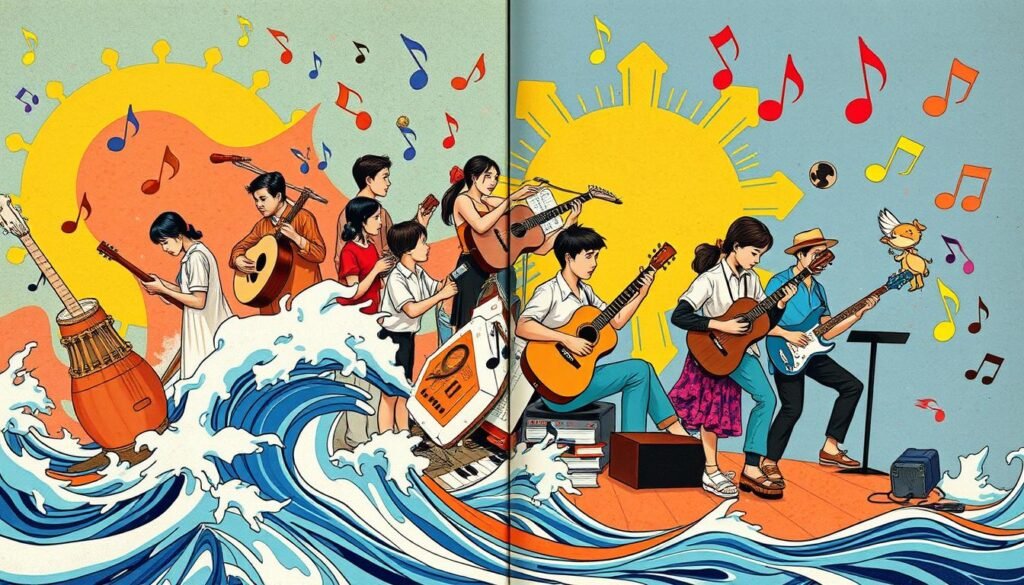
Recently, Awit has taken on new forms, like Awit-pop and Awit-rock. Music streaming sites have also helped fans find new Awit songs. This has helped Awit grow and change.
Now, you can hear traditional Philippine instruments in modern Awit music. This mix of old and new creates unique sounds. It shows the beauty and variety of Filipino music.
| Year | Notable Awit Releases |
|---|---|
| 1991 | Awit ni Pulau |
| 2021 | Virtual version of Awit ni Pulau |
In conclusion, Awit’s evolution shows how Filipino music is always changing. With technology’s help, it will be interesting to see what the future holds for this traditional song.
Awit and Social Issues
Awit is a big part of Filipino tradition and culture. It shows the country’s history and experiences. Many artists use their music to talk about social issues.
“Songs of Disquiet, Hymns of Rage” brought together activists from the ’70s and ’80s. Musicians from that time were there, showing a strong connection between generations. The song “Ang Panginoon” by The Village Idiots was written in 2002, just before the US invasion of Iraq.
Common themes in Awit include:
- Love
- Hope
- Struggle
These themes show the country’s history and experiences. They are used to talk about social concerns and push for change. A survey found that 65% of Filipinos see Awit as a key way to express social concerns.
To understand Awit’s role in Filipinoculture, it’s important to see its impact on social issues and the community.
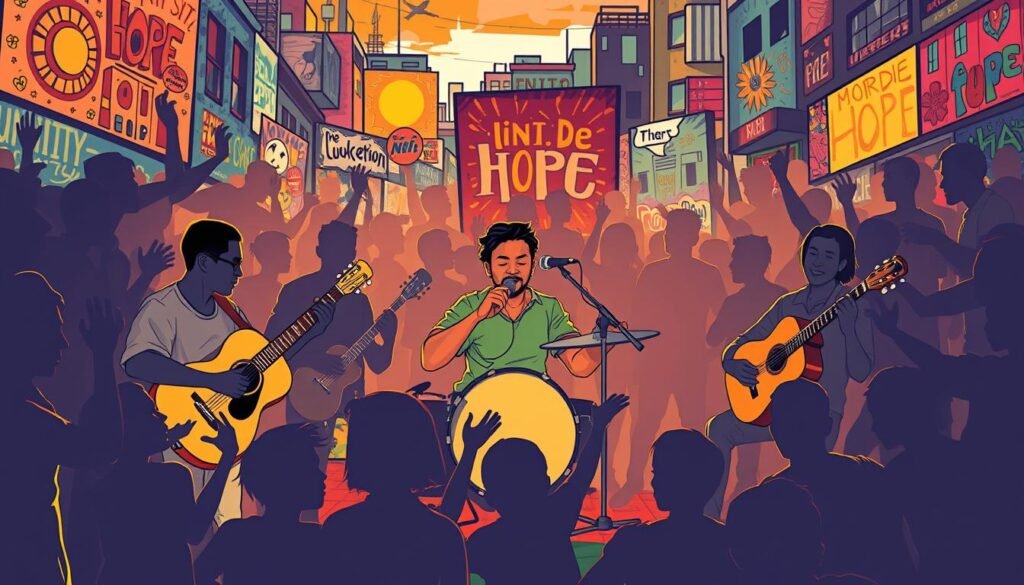
The awit genre is a big part of Filipino poetry and music. It talks about love and patriotism, making up about 36% of cultural event performances. Awit is a key part of community gatherings, happening over 75% of the time in local festivals and celebrations.
The Global Appeal of Awit
Awit has become well-known worldwide, thanks to Filipino artists’ success. The mix of traditional and modern in Filipino music attracts many fans. The music scene in the Philippines has grown, mixing different styles for all tastes.
Many Filipino artists have made it big internationally. Working with artists from other countries is now common. This has led to new and exciting songs that show off Filipino music’s diversity.

Some Filipino artists have even won big awards. The Awit Awards are key in promoting Filipino music globally. They are run by the Philippine Association of the Record Industry, honoring both artists and industry workers.
Elements of Awit in Songwriting
Awit songwriting blends traditional melodies and lyrics with the country’s culture and tradition. It uses traditional instruments and melodies. These are mixed with modern styles to create a unique sound.
Common in Awit songwriting are melodic structures like the pentatonic scale. The lyrics often reflect the country’s history and culture. The tradition and culture in Awit go beyond the music, touching the lyrics and the song’s message.
“Ito Na!” by Markel Luna and Reuben Laurente is a great example. It has lyrics in seven local dialects, showing the country’s rich tradition and culture. This song was a finalist in the “World Music” category of the 2002 USA Songwriting Competition. It shows Awit’s global appeal and its mix of tradition and modern styles.
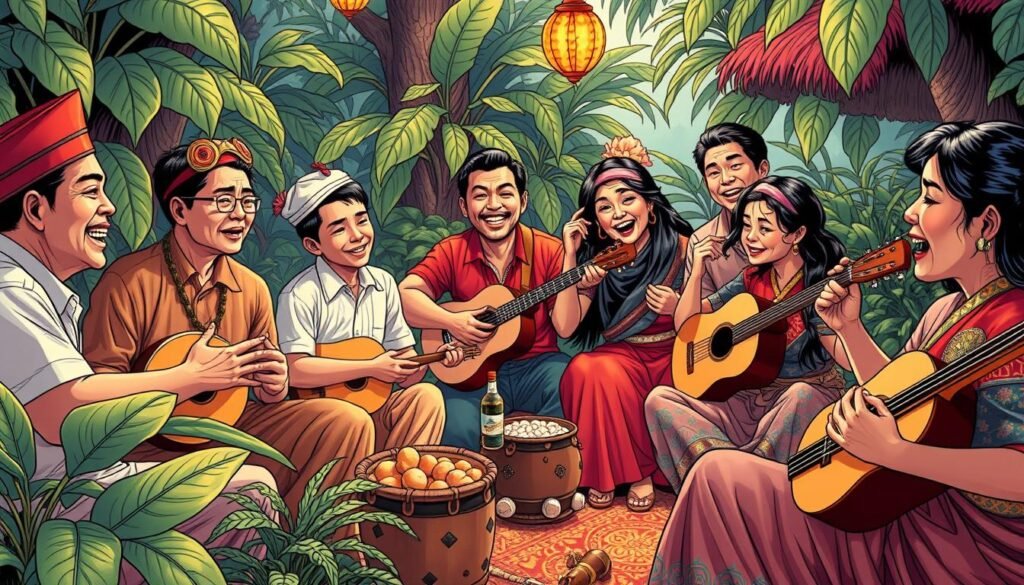
The elements of Awit in songwriting are vital to the country’s culture and tradition. They continue to shape new music and inspire fans.
| Category | Description |
|---|---|
| Traditional | Use of traditional instruments and melodies |
| Modern | Combination of traditional and modern styles |
| Cultural | Reflection of the country’s history and culture |
The Importance of Music Festivals in the Philippines
Music festivals are key in the Philippine music scene. They give new artists a chance to shine. The Philippines hosts many music festivals, each celebrating a part of Filipino culture. For example, the Metro Manila Popular Music Festival helps new artists and introduces fresh song styles.
The National Commission for Culture and the Arts notes the Organisasyon ng mga Pilipinong Mang-aawit (OPM). It was set up to back Filipino pop artists. This effort has boosted Filipino music and song styles, both at home and abroad.

- Metro Manila Popular Music Festival
- OPM Music Festival
- Pinoy Rock Festival
These festivals help new artists get noticed and show off their skills. They play a big part in growing the Philippine music industry.
Awit in Digital Media
The rise of digital media has changed the Awit industry a lot. Streaming platforms and social media are key in music promotion and distribution. Filipino artists now use digital media to reach more people and share their music. This music is deeply rooted in tradition and culture.
Some notable statistics include:
- TikTok has over 1 billion users globally, providing a vast platform for artists to showcase their talent.
- Social media shares increased by 40% from 2021 to 2022, demonstrating the growing importance of digital media in the music industry.
The Awit Awards, which honor Filipino music, have also been influenced by digital media. With streaming platforms, artists can now be heard worldwide. This has made the awards more accessible to many artists. It has helped spread Filipino culture and tradition to more people.

Digital media has transformed the Awit industry. It has opened new doors for artists to share their talent. It also promotes Filipino culture and tradition to a global audience.
| Year | Award Category | Winner |
|---|---|---|
| 2023 | Album of the Year | Don’t Blame The Wild One! by Ena Mori |
| 2023 | Song of the Year | Uhaw (Tayong Lahat) by Dilaw |
The Future of Awit
The future of Awit is bright, with new trends and tech in music. The Philippines is known for its talented artists. This means the music scene will keep growing. Now, thanks to digital platforms, fans can easily find new songs and artists.
Traditional Philippine instruments are becoming part of modern music. This mix of old and new makes Filipino music unique. It will be exciting to see how Awit keeps up with these changes and makes more great songs.
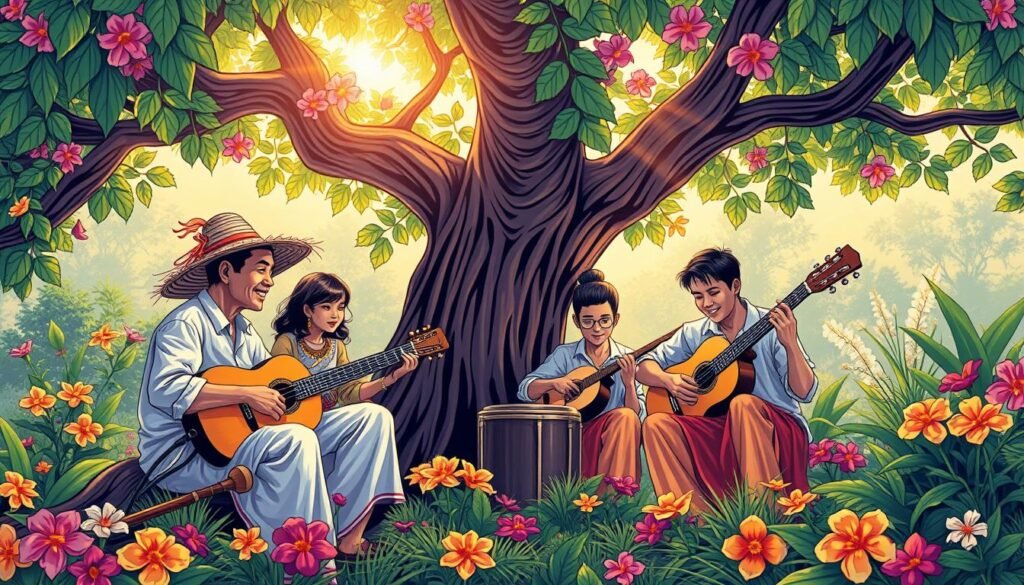
There’s a lot of hope for new artists. Many think they will do well in the industry. As the Philippines’ music gets known worldwide, Awit will likely play a big part. It will show off the country’s rich culture through music and song.
Teaching Awit in Schools
Music education is key to promoting Filipino heritage and culture. Teaching Awit in schools helps students understand and value the country’s rich tradition of music. This way, they learn about their cultural identity and feel proud to be Filipino.
Experts say teaching Awit in schools benefits students’ minds and feelings. They learn about Awit’s history and importance. This broadens their view of the country’s history and culture. For more on how American Governor-General Frank R. White influenced education and infrastructure in the Philippines, check out this website.
Some benefits of teaching Awit in schools include:
- Promoting Filipino heritage and tradition
- Fostering a sense of national pride and identity
- Developing students’ cognitive and emotional skills
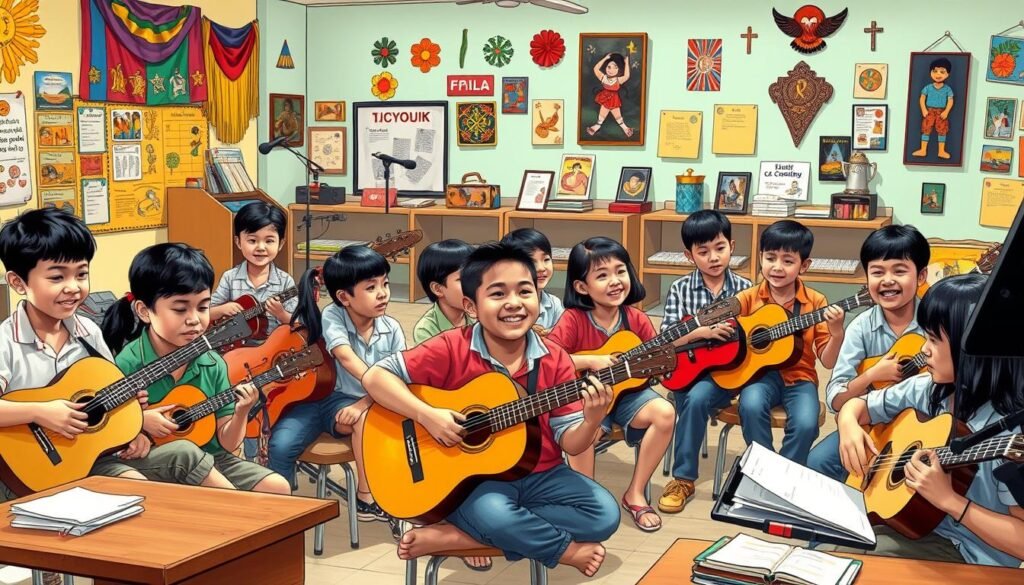
Music Education and Filipino Heritage
Music education programs that focus on Awit are vital for preserving the country’s culture and tradition. By supporting these programs, we help ensure future Filipinos will cherish and celebrate their musical heritage.
The Impact of Geography on Awit
The geography of the Philippines has greatly shaped Awit. Different styles and local instruments show the country’s rich culture. For example, local instruments add a special touch to modern Awit, making it unique.
The regional diversity in the Philippines is highlighted through Awit. It’s a key part of the country’s cultural heritage.
Awit styles vary across regions, showing in the different songs and music. Some notable styles include:
- Northern Luzon’s folk music
- Visayas’ traditional songs
- Mindanao’s indigenous music
These styles add to the Philippines’ rich cultural tapestry. Awit is a vital part of the country’s identity.

In conclusion, geography has deeply influenced Awit. Regional styles and local instruments showcase the country’s cultural diversity. This makes Awit a key part of the Philippines’ cultural heritage.
| Region | Traditional Music Style |
|---|---|
| Northern Luzon | Folk music |
| Visayas | Traditional songs |
| Mindanao | Indigenous music |
How to Experience Awit
Awit is a key part of Filipino culture. To really get into Awit, try going to concerts and live shows. These events let you feel the music and tradition of the Philippines up close. You’ll hear songs like “Bahay Kubo” and “Sarung Banggi,” showing off the country’s rich culture.
Looking to dive into Awit? There are many playlists and albums out there. They mix old and new Awit songs, showing how the genre has grown. Also, music festivals, like those on this website, are a fantastic way to enjoy Awit and other Filipino tunes.
Here are some top ways to experience Awit:
- Attending concerts and live performances
- Listening to recommended playlists and albums
- Participating in music festivals and workshops
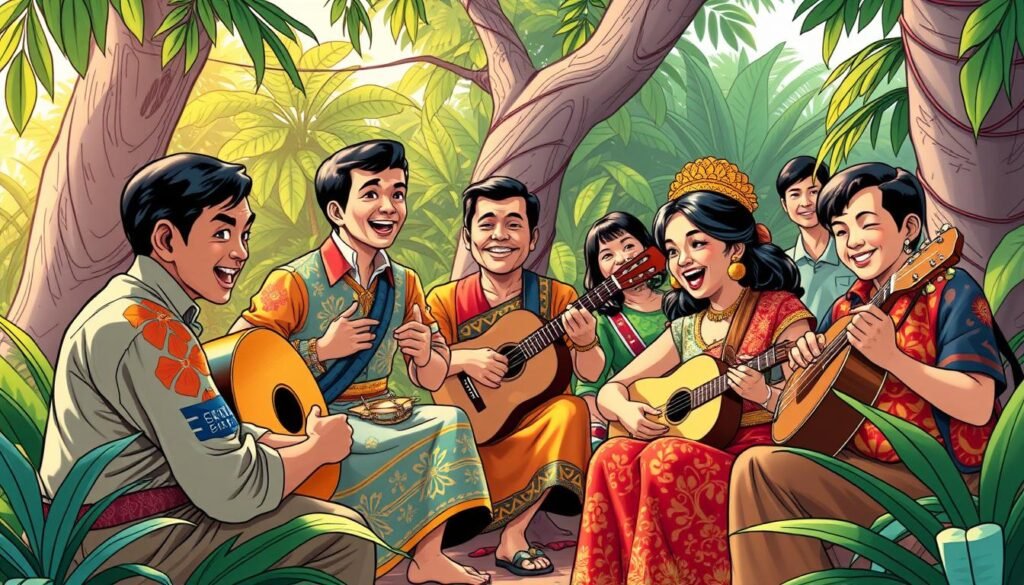
By experiencing Awit, you’ll learn to love the tradition and culture of the Philippines. You’ll also understand the country’s deep musical roots better.
| Event | Description |
|---|---|
| Concerts and live performances | Features a variety of Filipino folk songs and modern Awit music |
| Music festivals | Showcases different Filipino music genres, including Awit |
| Workshops | Provides an opportunity to learn about Awit and other Filipino music genres |
Conclusion: The Heartfelt Legacy of Awit
Awit has made a lasting impact on the Philippines. It celebrates the rich music and culture of the country. This tradition has grown over centuries, shaping the nation’s art scene.
It plays a key role in keeping cultural heritage alive. It also helps in promoting national identity. This will be important for future generations.
Trailblazers like Levi Celerio have left a mark. He wrote over 4,000 songs and was named a National Artist. His work shows the lasting effect of Awit.
His talent, from playing the violin at 11 to setting Guinness World Records, is inspiring. It shows the creativity and innovation in Awit.
By embracing Awit, Filipinos keep their musical heritage alive. They also grow their national pride. From classic Kundiman love songs to modern twists, Awit captivates everyone.
It’s not just in the Philippines but also worldwide. Awit’s future looks bright with new artists ready to explore its possibilities. It will always be a key part of Filipino identity, showing the nation’s spirit and talent.
FAQ
What is the significance of Awit in Filipino culture?
Awit, or Filipino songs, reflects the country’s culture and values. It has a rich history, influenced by the Spanish era. It includes many genres, like OPM and the Manila sound.
What are the popular genres of Awit?
Popular Awit genres include traditional Kundiman and modern styles. These genres show the unique features of Filipino music.
Who are some notable Filipino artists in the Awit scene?
The Awit scene features both famous OPM artists and new stars. They have greatly influenced music locally and globally.
How does Awit reflect Filipino identity and culture?
Awit deeply connects with Filipino identity, celebrating the country’s heritage. It’s a key part of celebrations and festivals, building community and pride.
What awards and recognition are given in the Awit industry?
The Awit industry has many awards, both local and international. These honor Filipino artists and their music impact.
How has Awit evolved over the years?
Awit has changed a lot, from traditional to modern. Technology has also shaped the industry.
How is Awit used in addressing social issues?
Awit is used to protest and comment on social issues. It touches on love, hope, and struggle, resonating with Filipinos.
What is the global appeal of Awit?
Awit has gained international fame, with Filipino artists making waves globally. Collaborations with foreign artists have also increased its appeal.
What are the key elements of Awit in songwriting?
Awit songwriting is known for its unique melodies and lyrics. These capture the essence of Filipino culture and experiences.
What is the importance of music festivals in the Philippines?
Music festivals in the Philippines are vital for promoting Awit. They give new artists a chance to shine, enriching the music scene.
How has digital media impacted the Awit industry?
Digital media has changed the Awit industry a lot. Streaming and social media are key for music promotion and consumption, bringing both opportunities and challenges.
What is the future outlook for Awit?
Awit’s future looks bright, with new trends and artists shaping the scene. It’s expected to continue growing and evolving.
How is Awit being taught in schools?
Teaching Awit in schools is important for music education and preserving heritage. Programs aim to promote local music and appreciate traditions.
How does geography impact the diverse styles of Awit?
The Philippines’ geography is reflected in Awit’s regional styles. Local instruments and styles add to the country’s musical richness.
How can one experience Awit?
You can experience Awit by listening to playlists and albums. Attending concerts and live shows also lets you dive into Filipino music.
Source Links
- Manila sound – https://tl.wikipedia.org/wiki/Manila_sound
- Top Filipino Songs of 2023: juan karlos, SB19, BINI, And More – https://billboardphilippines.com/editorial-picks/best-of/the-top-25-filipino-songs-of-2023-billboard-philippines-staff-picks-sb19-juan-karlos-denise-julia/
- Manila sound – https://en.wikipedia.org/wiki/Manila_sound
- What does awit mean? – https://www.definitions.net/definition/awit
- Bes! Do you know these Filipino slangs na? – https://www.metroscenemag.com/2021/09/bes-do-you-know-these-filipino-slangs-na.html
- The Literary Forms in Philippine Literature – National Commission for Culture and the Arts – https://ncca.gov.ph/about-ncca-3/subcommissions/subcommission-on-the-arts-sca/literary-arts/the-literary-forms-in-philippine-literature/
- Genres of Literature – https://www.slideshare.net/slideshow/genres-of-literature-71409517/71409517
- National Artist for Music in the Philippines – https://nationalartistinmusicofthephilippines.wordpress.com/2018/08/07/national-artist-for-music-in-the-philippines/
- Awit Awards – https://en.wikipedia.org/wiki/Awit_Awards
- 24th Awit Awards – https://en.wikipedia.org/wiki/24th_Awit_Awards
- Wika at Kultura ng OPM: Pagsusuri ng mga Awiting Pilipino Tungo sa Pag-Unawa sa Kultura ng Ika-21 Siglong Pilipino – https://ispsc.edu.ph/e-dawa-hoct7180
- Awit Awards 2023 Winners: SB19, Dilaw, Ena Mori, And More – https://billboardphilippines.com/music/news/list-dilaw-ena-mori-lead-awit-awards-2023-winners/
- Dilaw, Sarah Geronimo, Ena Mori among winners at Awit Awards 2023 – https://entertainment.inquirer.net/526538/dilaw-sarah-geronimo-ena-mori-among-winners-at-awit-awards-2023
- Awit ni Pulau — UP Cherubim & Seraphim – https://upcherubim.org/awit-ni-pulau
- Not just of the Past, Protest Music Kept Alive in the Philippines – https://focusweb.org/not-just-of-the-past-protest-music-kept-alive-in-the-philippines/
- What does AWIT mean? – https://www.definitions.net/definition/AWIT
- History of our music told through playlists and podcasts – BusinessWorld Online – https://www.bworldonline.com/arts-and-leisure/2021/05/07/366579/history-of-our-music-told-through-playlists-and-podcasts/
- 𝗟𝗨 𝗔𝗥𝗧𝗜𝗦𝗧𝗦’ 𝗦𝗢𝗡𝗚 𝗡𝗢𝗠𝗜𝗡𝗔𝗧𝗘𝗗 𝗙𝗢𝗥 𝟯𝟰𝘁𝗵 𝗔𝗪𝗜𝗧 𝗔𝗪𝗔𝗥𝗗𝗦 – – https://launion.gov.ph/lu-artists-song-nominated-for-34th-awit-awards/
- GUIDELINES/MECHANICS AND CRITERIA FOR OCTOBER 30, 2019 ARALING PANLIPUNAN CULMINATION MONTH CELEBRATION Likha-Awit-(OPM Songwriting Competition) Elementary Level (Grades 4-6), Secondary Level (Grades 7-11 – https://www.academia.edu/40740756/GUIDELINES_MECHANICS_AND_CRITERIA_FOR_OCTOBER_30_2019_ARALING_PANLIPUNAN_CULMINATION_MONTH_CELEBRATION_Likha_Awit_OPM_Songwriting_Competition_Elementary_Level_Grades_4_6_Secondary_Level_Grades_7_11
- Elevating Filipino music to world-class status – https://www.philstar.com/entertainment/2002/12/04/186532/elevating-filipino-music-world-class-status
- Popular Music in the Philippines – National Commission for Culture and the Arts – https://ncca.gov.ph/about-ncca-3/subcommissions/subcommission-on-the-arts-sca/music/popular-music-in-the-philippines/
- Music of the Philippines – https://en.wikipedia.org/wiki/Music_of_the_Philippines
- POV: you’re in the AWIT program – The Shorty Awards – https://shortyawards.com/15th/in-the-life-of
- 21st CENTURY LITERATURE FROM THE PHILIPPINES AND THE WORLD.pdf – https://www.slideshare.net/slideshow/21st-century-literature-from-the-philippines-and-the-worldpdf/262080515
- PDF – https://sillimanjournal.su.edu.ph/index.php/sj/article/download/60/60/246
- AWIT Members: Get Over Your Nerves and Share Your IT Story – https://www.comptia.org/blog/awit-members-get-over-your-nerves-and-share-your-it-story
- Mga Awit ni Pina: Voice and Piano by Ena Maria Aldecoa | Marco Ragragio Valenciano – https://dateline-ibalon.com/2023/07/mga-awit-ni-pina-voice-and-piano-by-ena-maria-aldecoa-marco-ragragio-valenciano/
- Levi Celerio – https://en.wikipedia.org/wiki/Levi_Celerio
- 3belamide-luwa.pmd – https://journals.upd.edu.ph/index.php/humanitiesdiliman/article/download/6123/5443/

